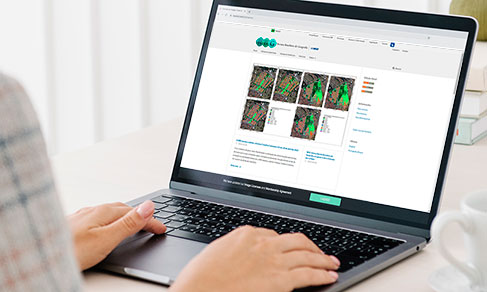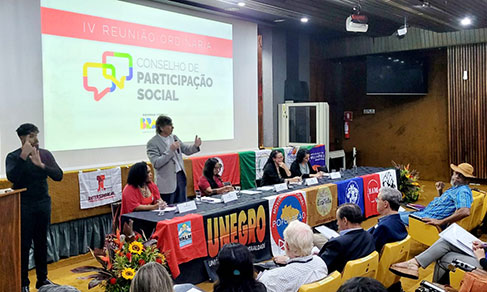Interview: Maria Vilma supervises Census of Agriculture in search of an updated portrait of our rural areas
October 09, 2017 09h00 AM | Last Updated: October 09, 2017 10h02 AM
Since the 2nd of October, almost 19 thousand enumerators have been visiting agriculture properties all over the country. Their objective is to visit more than 5.3 million agricultural units existing in Brazil, in order to produce an updated portrait of the Brazilian rural sector. Leading the census operation that will make the IBGE busy for the next five months, is Maria Vilma Salles Garcia, head of the Department of Census Operations. This year she has celebrated her 40th anniversary at the IBGE, having been in charge of four successful census operations (the population censuses of 1991 and 2010 and the censuses of agriculture/population count of 1996 and 2007).
In this interview to the IBGE New Agency, Maria Vilma recalls that the scarcity of financial resources to cover the expected budget of the Census of Agriculture – R$ 1.3 billion – almost prevented the operation from taking place. But as President Paulo Rabello de Castro took office at the IBGE in 2016, it was possible to keep the project. Cutting down on expenses was inevitable, so the current operation has an overall budget of only R$ 780 million (2017/2018). For that reason it was necessary to redefine all the steps, starting from the questionnaire, which was reduced so that it could be answered in half the expected time (in 45 minutes). Since fewer workers have been contracted to work in census activities, the data collection period has been extended from three to five months.
Ten years after collecting information about the rural sector in Brazil, the IBGE is now ready to conduct the most complete statistical and territory-covering investigation about agriculture in the country, with initial results expected for May 2018. According to Maria Vilma, “everyone will benefit from the new data, the government will be able to improve public policies for the agricultural sector, the private sector and entities in general will have the chance to plan better activities if they have an updated portrait of the rural reality”.

IBGE News Agency: What has changed in the Census of Agriculture in comparison with the 2007 editions (Census of Agriculture and population Count)?
Maria Vilma Salles Garcia: When we started planning the Census of Agriculture, in 2013, it would be conducted in 2015, and the Population Count would also take place. There would be a sequence of operations, not simultaneous ones, as in 2007. because of lack of financial resources, the Census of Agriculture was postponed and ended up being rescheduled for April 208.
With the change of presidents, in 2016, the new one, Paulo Rabello de Castro, decided to anticipate the Census and conduct the operation from February 2017 to February 2018. The reduced budget led to a series of changes. First of all, in the questionnaire: the 1,5 hour interview should last only 45 minutes; we no longer have a team per municipality, but a specific team for a group of municipalities. This way we have managed to reduce the number of enumerators, from 62 thousand to 18.8 thousand, and also the supervision staff. The number of Portable Data Collection Devices available has also decreased, but we extended the period of data collection from three to five months. After these changes we have managed to stick to the budget. Now we are prepared to start the Census. We are counting, especially, on the strength of our IBGE State Units to accomplish that goal.
IBGE News Agency: Is the Census of Agriculture use the same collection model as in the 2007 edition? Why?
Maria Vilma Salles Garcia: This Census will use the same technology employed in 2007, which is, basically, to transfer the collected information straight to the Data Processing Center (CPD). In the 2010 Population Census, the equipment would transfer information to the central computer at night and then the data would be retransmitted to the CPD. For the 2017 Census of Agriculture, the Directorate of Data Processing reported a successful experience in the direct transfer of PNADC data (Continuous National Household Sample Survey), and, because of that, they decided to do the same in the current operation. Technological advances have allowed data transfer to be updated and improved.
IBGE News Agency: What other advances will be seen in the 2017 Census of Agriculture?
Maria Vilma Salles Garcia: The new georeferencing technologies have helped improve the geoprocessing steps, our maps are much better after the use of satellite images. The equipment used by the enumerator has location tools that can guide them on the way, show if there are rivers ahead, what to visit next, the nearest establishments. It will also indicate whether the enumerator is within the boundaries of their own enumeration area. From the estimated 5.3 million rural properties, 4 million are georeferenced and form a primary list that will help the enumerator cover the sector. Another feature is that the collection supervisor will monitor enumerators on their way, and will be able to assist them at any time in case of doubt or difficulty. All these updates will make our collection safer and more precise. Also, the equipment used this time is lighter and has a wider screen. Another positive change is the option of real-time contact between the enumerator and the supervisor.
IBGE News Agency: How was the training of all those 18 thousand enumerators, last week?
Maria Vilma Salles Garcia: Training was one of the items that needed to be redefined according to our budget. In 2010, we had distance-learning in all classes. In our shortened 2017/2018 schedule, there was no time to produce such a thing. So we used three videos from the previous edition – institution, route in the enumeration area and concept of agricultural establishment; for all the rest we made use of slides. In spite of that, the manual is very detailed, the slides are well explained and have received positive evaluations so far.
IBGE News Agency: What is the profile of a good enumerator?
Maria Vilma Salles Garcia: First of all, that professional has to be able to approach people, the first contact with the informant is a key step. It is necessary to explain what their job is all about, what will be done, and gain the informant’s confidence. That is 50% of the job. The secret is to establish a god relationship. The enumerator has to deal with some resistance the informant might have, and ask if it is ok to answer the questionnaire or if he might try again later at some scheduled time. Those techniques pave the way to confidence.
IBGE News Agency: How difficult is it to conduct a Census in such a big and diverse country?
Maria Vilma Salles Garcia: Regional diversity is very complicated. It is much easier to interview establishments nearby, in Rio de Janeiro, São Paulo. We need more availability to visit municipalities in Amazonas, Pará, because the ways of access are very diverse. In the North you have to rent a boat, there are Indian areas, places marked by land conflicts. Geographic diversity is our biggest challenge.
IBGE News Agency: Are there any partners in the dissemination of the 2017 Census of Agriculture and its activities?
Maria Vilma Salles Garcia: The campaigns shared with the agribusiness representatives have helped a lot. We have been in contact with the Brazilian Agribusiness Association (Abag), with the Organization of Brazilian Cooperatives (OCB), with the National Confederation of Agriculture (CNA), among other representatives from civil society. That institutional relationship is na advance in comparison with what we had in 2007. Regarding smaller establishments we have received support from the National Confederation of Rural Workers (Contag). There will also be a publicity campaign promoted by the Presidency’s Secretariat for Social Communication (Secom).
IBGE News Agency: Why is it important to anwer and participate in the Census of Agriculture?
Maria Vilma Salles Garcia: Because information is a valuable good and it has to be new…dated information is useless. What we know for sure about the agricultural sector has been known since 2007. New data will benefit everyone, bring new public policies for the sector, and better planning by private entities when they get a renewed picture of the rural sector in Brazil. So, we all need to welcome the enumerators and answer their questions correctly. That is what Brazil is counting on!
Interview: Adriana Saraiva (collaboration of Marina Cardoso, intern)
Photograph: Pedro Girão



















